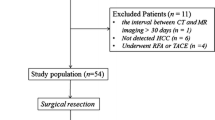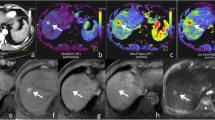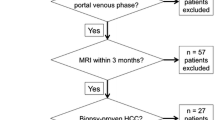Abstract
Objectives
To retrospectively compare the accuracy of detection of hypervascular hepatocellular carcinoma (HCC) by multiphasic multidetector CT and by gadoxetate disodium-enhanced MR imaging.
Methods
After ethical approval, we analysed a total of 73 hypervascular HCC lesions from 31 patients suspected of having HCC, who underwent both gadoxetate disodium-enhanced MR imaging and multiphasic multidetector CT. Five blinded observers independently reviewed CT images, as well as dynamic MR images alone and combined with hepatobiliary phase MR images. Diagnostic accuracy (Az values), sensitivities and positive predictive values were compared by using the Scheffe post hoc test.
Results
The mean Az value for dynamic and hepatobiliary phase MR combined (0.81) or dynamic MR images alone (0.78) was significantly higher than that for CT images (0.67, P < 0.001, 0.005, respectively). The mean sensitivity of the combined MR images (0.67) was significantly higher than that of dynamic MR alone (0.52, P < 0.05) or CT images (0.44, P < 0.05). The mean positive predictive values were 0.96, 0.95 and 0.94, for CT, dynamic MR alone and combined MR images, respectively.
Conclusions
Compared with multiphasic multidetector CT, gadoxetate disodium-enhanced MR imaging combining dynamic and hepatobiliary phase images results in significantly improved sensitivity and diagnostic accuracy for detection of hypervascular HCC.
Key Points
• Gadoxetate disodium is a new liver-specific MR imaging contrast agent. Gadoxetate disodium-enhanced MRI helps the assessment of patients with liver disease.
• It showed high diagnostic accuracy for the detection of hepatocellular carcinoma.




Similar content being viewed by others
References
Bruix J, Sherman M (2005) AASLD practice guideline: management of hepatocellular carcinoma. Hepatology 42:1208–1236
Bruix J, Sherman M (2011) AASLD practice guideline: management of hepatocellular carcinoma: an update. Hepatology 53:1020–1022
Bruix J, Sherman M, Llovet JM et al (2001) Clinical management of hepatocellular carcinoma: conclusions of the Barcelona-2000 EASL conference. J Hepatol 35:421–430
Torzilli G, Minagawa M, Takayama T et al (1999) Accurate preoperative evaluation of liver mass lesions without fine-needle biopsy. Hepatology 30:889–893
Levy I, Greig PD, Gallinger S et al (2001) Resection of hepatocellular carcinoma without preoperative tumour biopsy. Ann Surg 234:206–209
Schuhrnann-Giarnpieri C, Schmitt-Willich H, Press WR et al (1992) Preclinical evaluation of Gd-EOB-DTPA as a contrast agent in MR imaging of the hepatobiliary system. Radiology 183:59–64
Clement O, Mühler A, Vexler V et al (1992) Gadolinium-ethoxybenzyl-DTPA: a new liver-specific magnetic resonance contrast agent-kinetic and enhancement patterns in normal and cholestatic rats. Invest Radiol 27:612–619
Mühler A, Clément O, Saeed M et al (1993) Gadolinium-ethoxybenzyl-DTPA: a new liver-directed magnetic resonance contrast agent-absence of acute epatotoxic, cardiovascular, or immunologic effects. Invest Radiol 28:26–32
Weinmann HJ, Schuhmann-Gampieri G, Schmitt-Willich H et al (1991) A new lipophilic gadolinium chelate as a tissue-specific contrast medium for MRI. Magn Reson Med 22:222–228
MuehlerA HI, Weinmann HJ (1994) Elimination of Gd-EOB-DTPA in severely impaired liver and kidney excretory function. Invest Radiol 29:213–216
Kitao A, Matsui O, Yoneda N et al (2011) The uptake transporter OATP8 expression decreases during multistep hepatocarcinogenesis: correlation with gadoxetic acid enhanced MR imaging. Eur Radiol 21:2056–2066
Reimer P, Schneider G, Schima W (2004) Hepatobiliary contrast agents for contrast-enhanced MRI of the liver: properties, clinical development and applications. Eur Radiol 14:559–578
Reimer P, Rummeny EJ, Shamsi K et al (1996) Phase II clinical evaluation of Gd-EOB-DTPA: dose, safety aspects and pulse sequence. Radiology 199:177–183
Golfieri R, Renzulli M, Lucidi V, Corcioni B, Trevisani F, Bolondi L (2011) Contribution of the hepatobiliary phase of Gd-EOB-DTPA-enhanced MRI to Dynamic MRI in the detection of hypovascular small (≤2 cm) HCC in cirrhosis. Eur Radiol 21:1233–1242
Löwenthal D, Zeile M, Lim WY et al (2011) Detection and characterisation of focal liver lesions in colorectal carcinoma patients: comparison of diffusion-weighted and Gd-EOB-DTPA enhanced MR imaging. Eur Radiol 21:832–840
Shimada K, Isoda H, Hirokawa Y, Arizono S, Shibata T, Togashi K (2010) Comparison of gadolinium-EOB-DTPA-enhanced and diffusion-weighted liver MRI for detection of small hepatic metastases. Eur Radiol 20:2690–2698
Ricke J, Thormann M, Ludewig M et al (2010) MR-guided liver tumour ablation employing open high-field 1.0T MRI for image-guided brachytherapy. Eur Radiol 20:1985–1993
Choi JS, Kim MJ, Choi JY, Park MS, Lim JS, Kim KW (2010) Diffusion-weighted MR imaging of liver on 3.0-Tesla system: effect of intravenous administration of gadoxetic acid disodium. Eur Radiol 20:1052–1060
Tanimoto A, Lee JM, Murakami T, Huppertz A, Kudo M, Grazioli L (2009) Consensus report of the 2nd International Forum for Liver MRI. Eur Radiol 19:S975–S989
Zech CJ, Grazioli L, Jonas E et al (2009) Health-economic evaluation of three imaging strategies in patients with suspected colorectal liver metastases: Gd-EOB-DTPA-enhanced MRI vs. extracellular contrast media-enhanced MRI and 3-phase MDCT in Germany, Italy and Sweden. Eur Radiol 19:S753–S763
Reimer P, Rummeny EJ, Daldrup HE et al (1997) Enhancement characteristics of liver metastases, hepatocellular carcinomas, and hemangiomas with Gd-EOB-DTPA: preliminary results with dynamic MR imaging. Eur Radiol 7:275–280
Ichikawa T, Saito K, Yoshioka N et al (2010) Detection and characterization of focal liver lesions: a Japanese phase III, multicenter comparison between gadoxetic acid disodium-enhanced magnetic resonance imaging and contrast-enhanced computed tomography predominantly in patients with hepatocellular carcinoma and chronic liver disease. Invest Radiol 45:133–141
Kim SH, Kim SH, Lee J et al (2009) Gadoxetic acid-enhanced MRI versus triple-phase MDCT for the preoperative detection of hepatocellular carcinoma. AJR Am J Roentgenol 192:1675–1681
Kim YK, Kim CS, Han YM et al (2009) Detection of hepatocellular carcinoma: gadoxetic acid-enhanced 3-dimensional magnetic resonance imaging versus multi-detector row computed tomography. J Comput Assist Tomogr 33:844–850
Hammerstingl R, Huppertz A, Breuer J et al (2008) Diagnostic efficacy of gadoxetic acid (Primovist)-enhanced MRI and spiral CT for a therapeutic strategy: comparison with intraoperative and histopathologic findings in focal liver lesions. Eur Radiol 18:457–467
Halavaara J, Breuer J, Ayuso C et al (2006) Liver tumour characterization: comparison between liver-specific gadoxetic acid disodium-enhanced MRI and biphasic CT-a multicenter trial. J Comput Assist Tomogr 30:345–354
Huppertz A, Balzer T, Blakeborough A et al (2004) Improved detection of focal liver lesions at MR imaging: multicenter comparison of gadoxetic acid-enhanced MR images with intraoperative findings. Radiology 230:266–275
Huppertz A, Haraida S, Kraus A et al (2005) Enhancement of focal liver lesions at gadoxetic acid-enhanced MR imaging: correlation with histopathologic findings and spiral CT-initial observations. Radiology 234:468–478
Vogl TJ, Kümmel S, Hammerstingl R et al (1996) Liver tumours: comparison of MR imaging with Gd-EOB-DTPA and Gd-DTPA. Radiology 200:59–67
Bluemke DA, Sahani D, Amendola M et al (2005) Efficacy and safety of MR imaging with liver-specific contrast agent: U.S. multicenter phase III study. Radiology 237:89–98
Akai H, Kiryu S, Takao H et al (2009) Efficacy of double-arterial phase gadolinium ethoxybenzyl diethylenetriamine pentaacetic acid-enhanced liver magnetic resonance imaging compared with double-arterial phase multi-detector row helical computed tomography. J Comput Assist Tomogr 33:887–892
Murakami T, Takamura M, Kim T et al (2005) Double phase CT during hepatic arteriography for diagnosis of hepatocellular carcinoma. Eur J Radiol 54:246–252
Iannaccone R, Laghi A, Catalano C et al (2005) Hepatocellular carcinoma: role of unenhanced and delayed phase multi-detector row helical CT in patients with cirrhosis. Radiology 234:460–467
Hayat MA (2009) Methods of cancer diagnosis, therapy, and prognosis. Volume 5, Liver Cancer. Springer, New York, pp 221–235
Murakami T, Kim T, Takamura M et al (2001) Hypervascular hepatocellular carcinoma: detection with double arterial phase multi-detector row helical CT. Radiology 218:763–767
Tsuboyama T, Onishi H, Kim T et al (2010) Hepatocellular carcinoma: hepatocyte-selective enhancement at gadoxetic acid-enhanced MR imaging–correlation with expression of sinusoidal and canalicular transporters and bile accumulation. Radiology 255:824–833
Kogita S, Imai Y, Okada M et al (2010) Gd-EOB-DTPA-enhanced magnetic resonance images of hepatocellular carcinoma: correlation with histological grading and portal blood flow. Eur Radiol 20:2405–2413
Fleiss JL (1981) The measurement of interrater agreement. In Statistical methods for rates and proportions. 2nd ed., Wiley, New York, pp 212–236
Chakraborty DP, Winter LH (1990) Free-response methodology: alternate analysis and a new observer-performance experiment. Radiology 174:873–881
Doo KW, Lee CH, Choi JW et al (2009) “Pseudo washout” sign in high-flow hepatic hemangioma on gadoxetic acid contrast-enhanced MRI mimicking hypervascular tumour. Am J Roentgenol 193:W490–496
Sun HY, Lee JM, Shin CI et al (2010) Gadoxetic acid-enhanced magnetic resonance imaging for differentiating small hepatocellular carcinomas (2 cm in diameter) from arterial enhancing pseudolesions: special emphasis on hepatobiliary phase imaging. Invest Radiol 45:96–103
Marin D, Di Martino M, Guerrisi A et al (2009) Hepatocellular carcinoma in patients with cirrhosis: qualitative comparison of gadobenate dimeglumine-enhanced MR imaging and multiphasic 64-section CT. Radiology 251:85–95
Acknowledgements
This work was supported in part by a Grant-in-Aid for Young Scientists (21791191) from the Ministry of Education, Culture, Sports, Science and Technology and by Health and Labor Sciences Research Grants (KAKENHI), Japan Society for the Promotion of Science.
Author information
Authors and Affiliations
Corresponding author
Rights and permissions
About this article
Cite this article
Onishi, H., Kim, T., Imai, Y. et al. Hypervascular hepatocellular carcinomas: detection with gadoxetate disodium-enhanced MR imaging and multiphasic multidetector CT. Eur Radiol 22, 845–854 (2012). https://doi.org/10.1007/s00330-011-2316-y
Received:
Revised:
Accepted:
Published:
Issue Date:
DOI: https://doi.org/10.1007/s00330-011-2316-y




